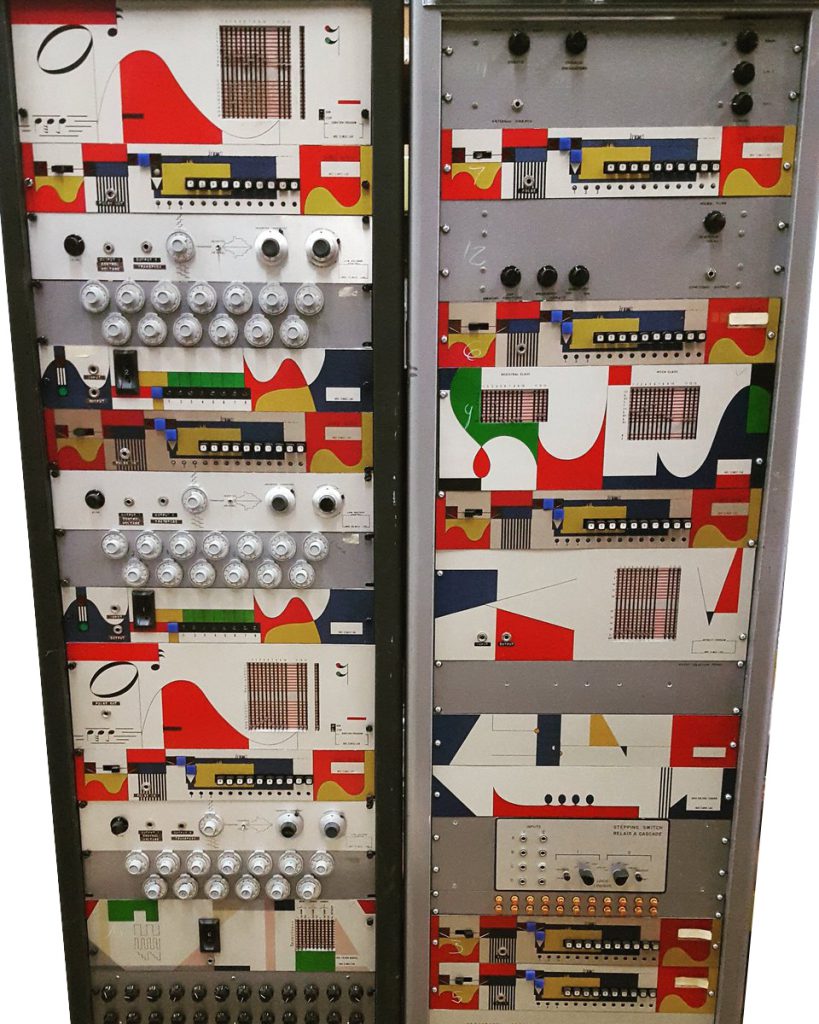Artefacts
Serial Sound Structure Generator
Serial Sound Structure Generator
(Accession Number: 1986.0008)
Dimensions: Height = 194cm, Length = 70cm, Width = 45cm (x 2 units)
Condition: Mechanical components in good condition. Electronic components in fair condition.
Material: Ferrous metal racks. Non-ferrous metal casing fronts. Metal working parts. Synthetic knobs, buttons, switches, and working parts.
The Serial Sound Structure Generator is a studio-oriented musical instrument designed by Canadian physicist Hugh Le Caine and built in the National Research Council of Canada’s (NRC) Electronic Music (ELMUS) Lab in Ottawa, Canada. It was created to expand upon the serial composition technique of using the repetition of a series of notes, typically a series of 12 tones, to create a musical composition. Le Caine’s goal was to introduce a means of not just ordering individual tones but also creating different patterns or sequences by adjusting and serializing other parameters to add new layers of expressivity to the technique.
The Serial Sound Structure Generator contains four modules, each designed to affect and serialize a different characteristic of sound: pitch, volume, timbre, and duration. Each module could store and automatically repeat four to thirteen values. The settings could also be adjusted during playback and recorded ‘live’ in the studio. Its voltage outputs could also control functions of other instruments such as the Special Purpose Tape Recorder. The Serial Sound Structure Generator was an extremely complex and powerful sequencer, capable of a wider range of functions than commercial analogue sequencers. It anticipated future applications of computers to electronic music production, and its functions were not duplicated before the advent of digital sound controllers.
The Serial Sound Structure Generator shown here is one of four versions of the instrument designed by Hugh Le Caine and built at the NRC ELMUS Lab between 1967 and 1970. The first (1967) version, on which Le Caine composed Music for Expo, was a popular attraction at the World Fair held that year in Montreal, Canada. The version here is the second and was built in 1968 for the Electronic Music Studio at McGill University in Montreal. Established in 1964, McGill’s studio was – after the NRC’s ELMUS Lab and the University of Toronto Electronic Music Studio (UTEMS) – the third electronic music studio established in Canada.
Particularly noteworthy about this 1968 version of the instrument is its visual aesthetic. Decorated with abstract artwork created by artist Anne-Lore Thompson, it was designed to appear less “cold” and “technical” – and therefore more approachable and accessible – than most electronic studio instruments available at the time. The abstract red, yellow, blue, and black shapes in Thompson’s work, embellished with musical notes and other sound signifiers, were meant to evoke the different functions and sonic outputs of the instrument’s various controls. One of the distinctive panels shows a sequence of thirteen controls, each of which has a switch that could activate or de-activate an element of the overall sound. Separate visuals for each of the four modules made it easier for composers to identify a module as they shaped compositions by adjusting one or the other.
In 1986 McGill University donated this Serial Sound Structure Generator to the National Museum of Science and Technology in Ottawa, Canada (now Ingenium – Canada’s Museums of Science and Innovation) where it resides today. The other three versions of the instrument, including the 1967 prototype, are also held in Ingenium’s permanent collection. The 1968 instrument is currently on display in the Canada Science and Technology Museum’s Sound by Design gallery in Ottawa.
© 2015 – 2025 Humboldt-Universität zu Berlin






